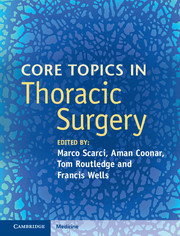Book contents
- Frontmatter
- Contents
- List of contributors
- Section I Diagnostic work-up of the thoracic surgery patient
- Section II Upper airway
- Section III Benign conditions of the lung
- 7 Congenital and developmental lung malformations
- 8 Lung volume reduction surgery for the treatment of advanced emphysema
- 9 Surgical aspects of infectious conditions of the lung
- 10 Treatment of haemoptysis
- Section IV Malignant conditions of the lung
- Section V Diseases of the pleura
- Section VI Diseases of the chest wall and diaphragm
- Section VII Disorders of the esophagus
- Section VIII Other topics
- Index
- References
9 - Surgical aspects of infectious conditions of the lung
from Section III - Benign conditions of the lung
Published online by Cambridge University Press: 05 September 2016
- Frontmatter
- Contents
- List of contributors
- Section I Diagnostic work-up of the thoracic surgery patient
- Section II Upper airway
- Section III Benign conditions of the lung
- 7 Congenital and developmental lung malformations
- 8 Lung volume reduction surgery for the treatment of advanced emphysema
- 9 Surgical aspects of infectious conditions of the lung
- 10 Treatment of haemoptysis
- Section IV Malignant conditions of the lung
- Section V Diseases of the pleura
- Section VI Diseases of the chest wall and diaphragm
- Section VII Disorders of the esophagus
- Section VIII Other topics
- Index
- References
Summary
Empyema
Background
Pleural empyema is defined as collection of pus in the pleural space. It was first described by an Egyptian physician in 3000 BC, but Hippocrates was more famously credited with its description. The mainstay of early treatment was open drainage; however, associated mortality was high. In 1917–1919, during the influenza epidemic, an Empyema Commission recommended closed chest tube, avoidance of early open drainage, obliteration of pleural space and nutritional support for the patient. These principles remain the basis of treatment today.
Empyema remains a common clinical problem, with an incidence of about 80,000 in the UK and United States. The mortality and morbidity associated with the condition remain high.
Etiology
Empyema may be caused by spread of infection from organs contiguous to the pleural space, direct inoculation of the pleura due to trauma or as a result of haematogenous spread. Contiguous spread is the most common modality and accounts for over half of all cases. Most commonly it arises from the lung or structures such as mediastinum, deep cervical organs, chest wall and spine or organs below the diaphragm. The other major route is secondary to thoracic procedures such as thoracocentesis, post-operatively following thoracic or oesophageal surgery or secondary to trauma. Rarely empyema develops as a result of haematogenous spread from a distant source.
Chronic respiratory diseases, diabetes mellitus, malignancies, immunosuppression, gastro-oesophageal reflux disease and alcohol and drug addiction increase the risk of developing empyema.
The incidence of complicated parapneumonic effusion or empyema in patients requiring hospital admission for community-acquired pneumonia is over 7%. Hypoalbuminemia, hyponatremia, thrombophilia, raised C-reactive protein (CRP) and alcohol and intravenous drug abuse were independently associated with the development of complicated parapneumonic effusion or empyema. Interestingly, it appears COPD is protective against the development of empyema.
Over half of patients with community-acquired pneumonia develop pleural effusions; however, the majority are sterile sympathetic effusions destined to resolve. In about 30% of these patients, the condition progresses to complicated parapneumonic effusion (CPPE) or to empyema.
The incidence of empyema following post-traumatic haemothorax is over 25%. Risk factors for its development include rib fractures, (injury severity score) ISS > 25 and the need for additional interventions to evacuate retained haemothorax. The use of prophylactic antibiotics in patients with chest trauma can decrease the incidence of post-traumatic empyema and pneumonia.
- Type
- Chapter
- Information
- Core Topics in Thoracic Surgery , pp. 86 - 104Publisher: Cambridge University PressPrint publication year: 2016
References
- 1
- Cited by



